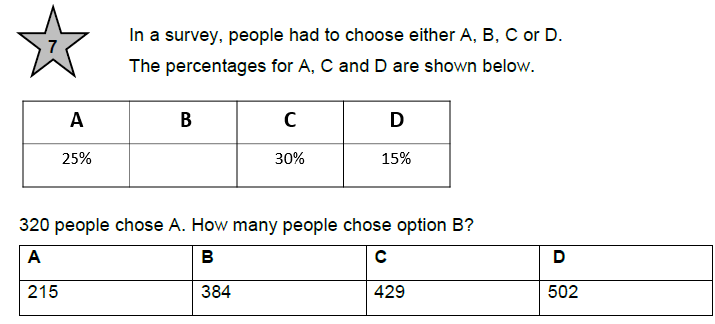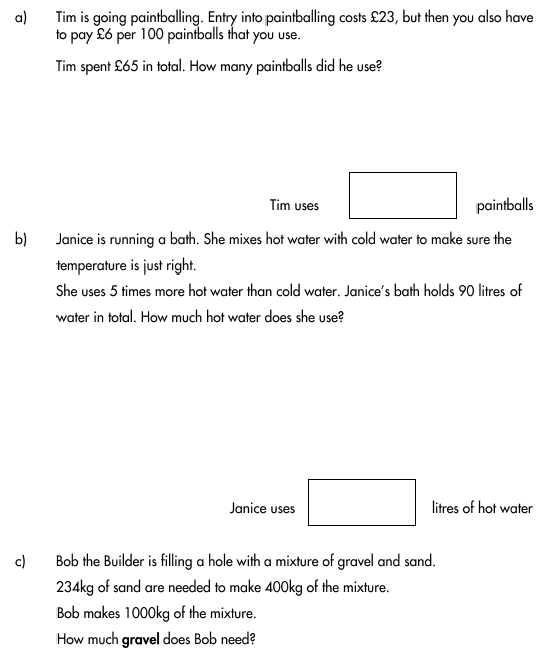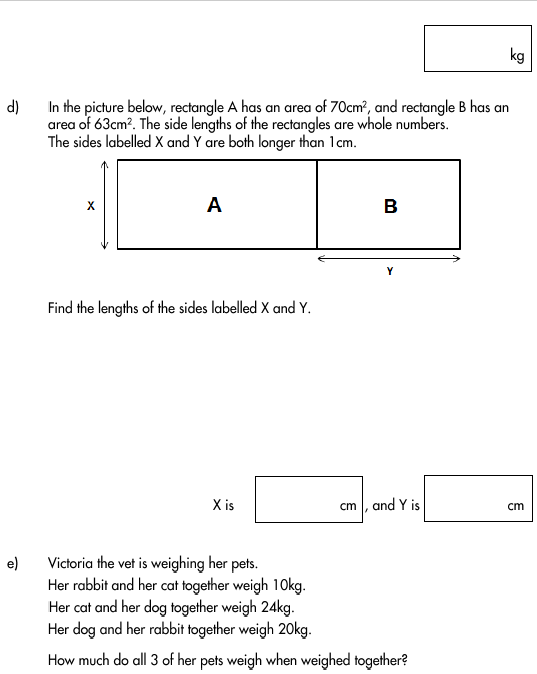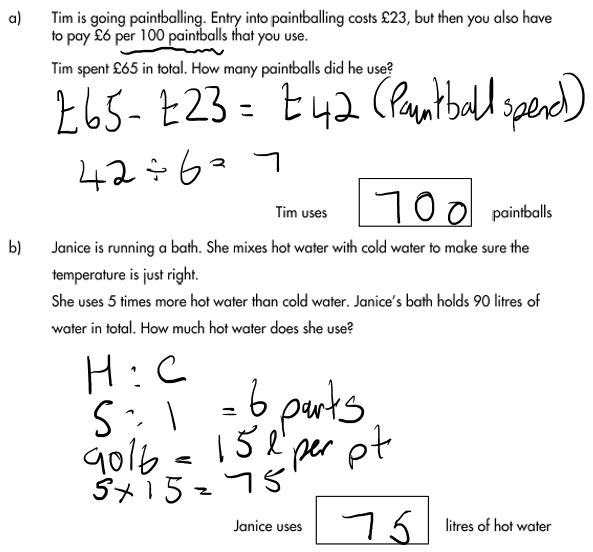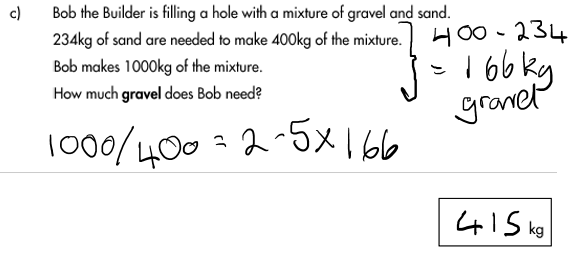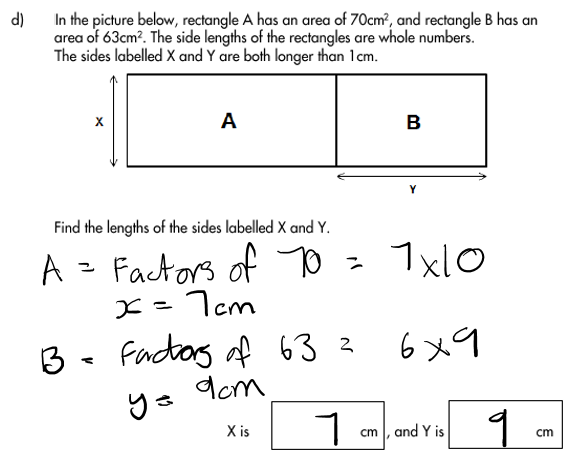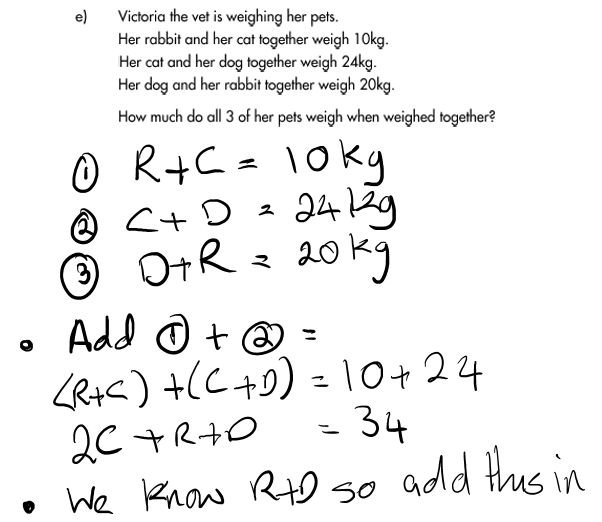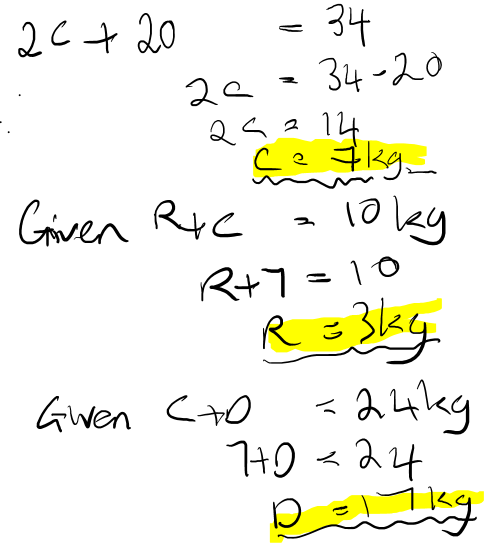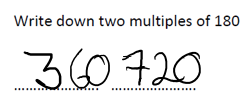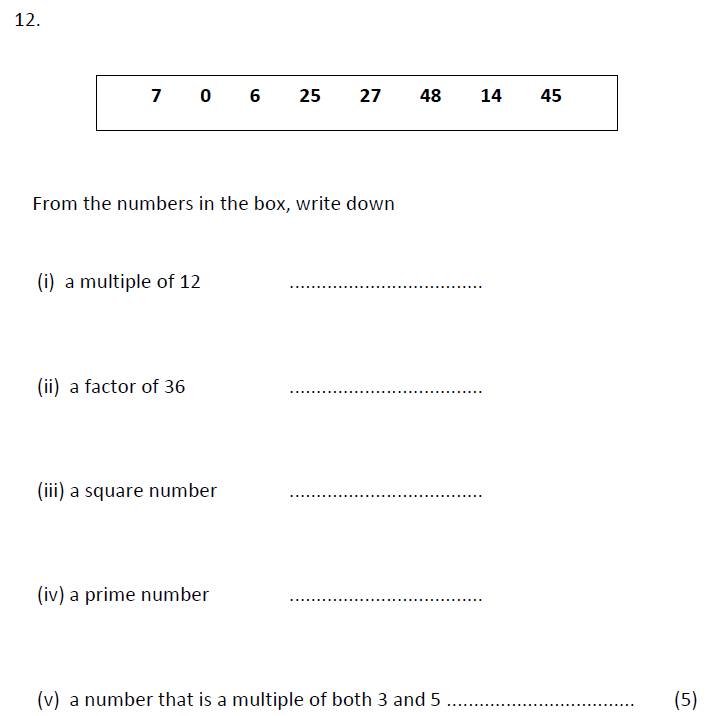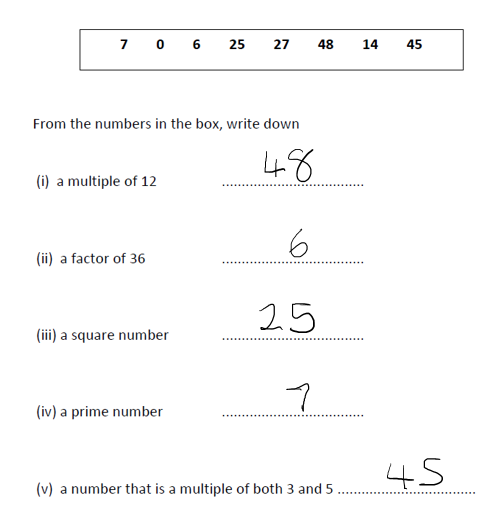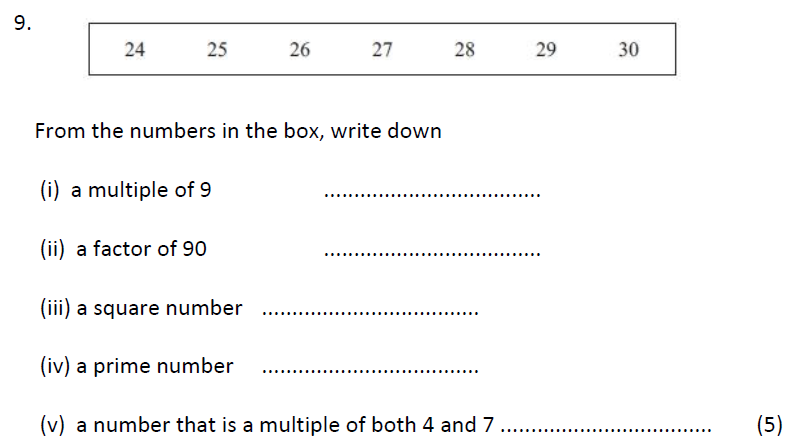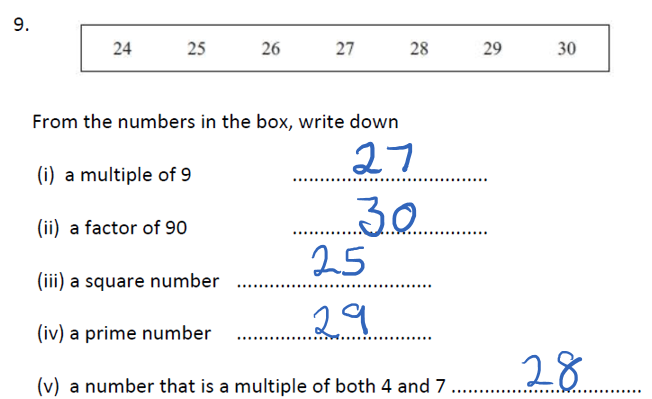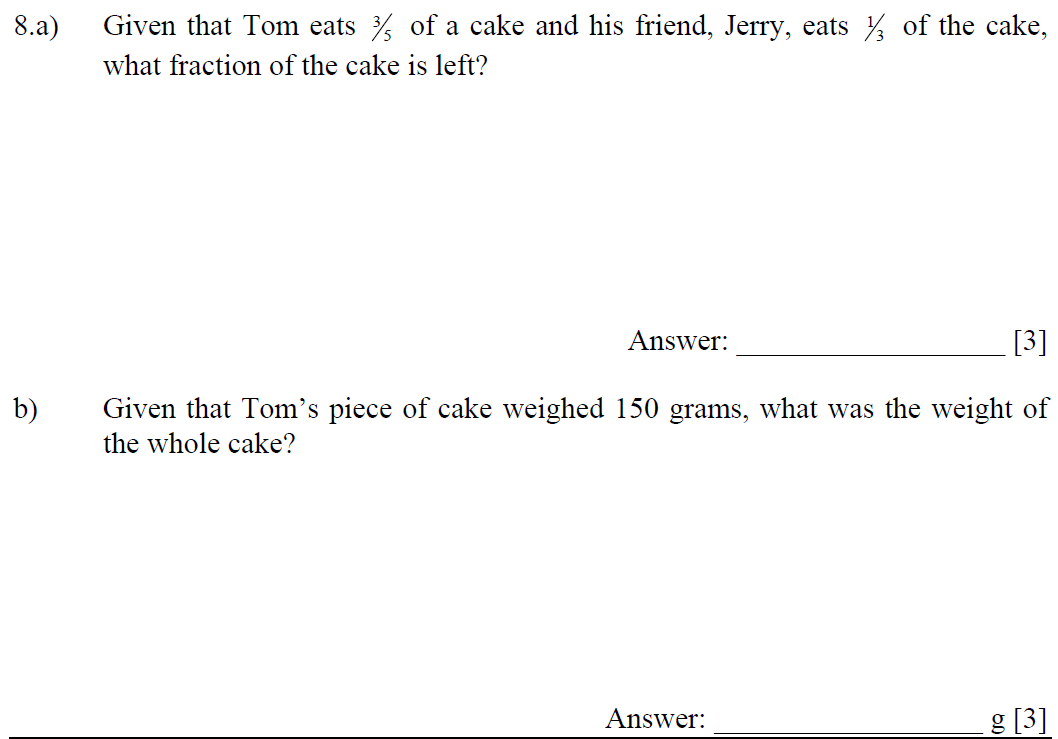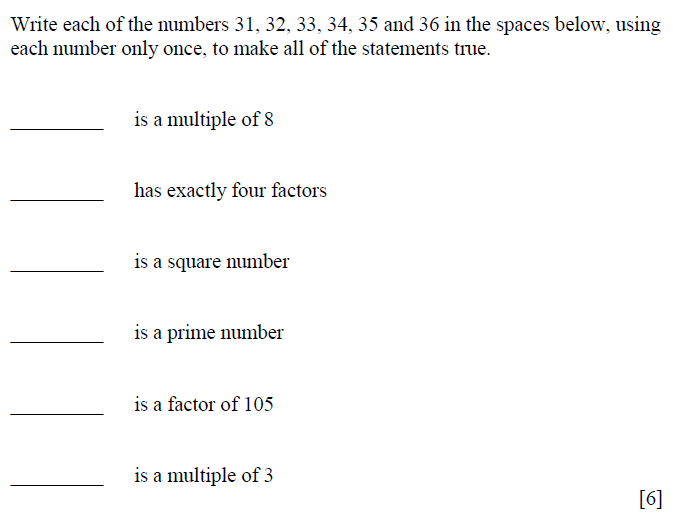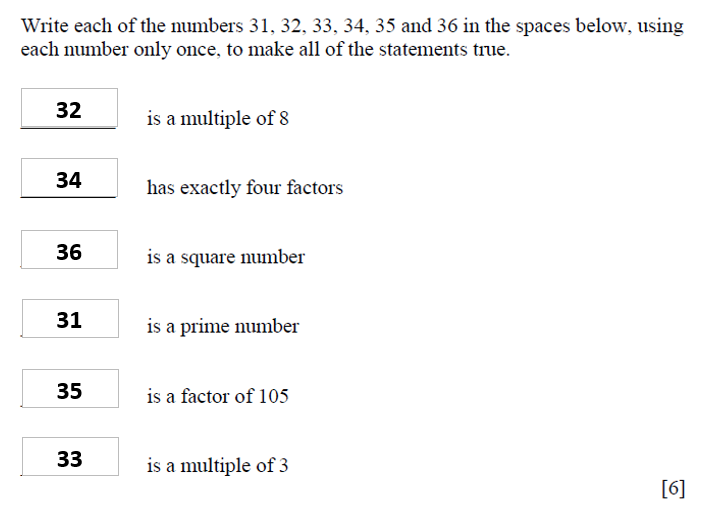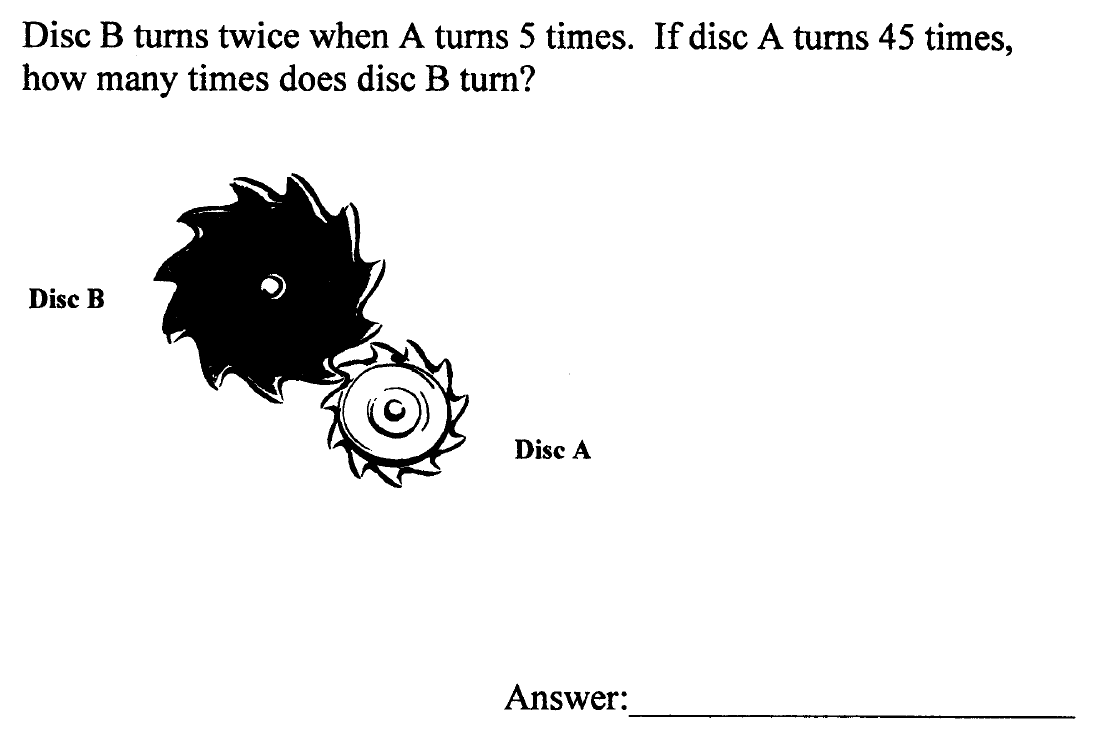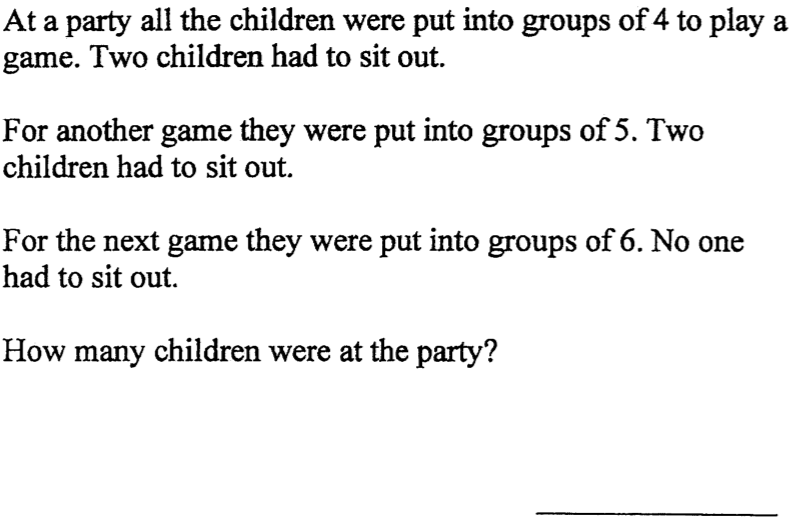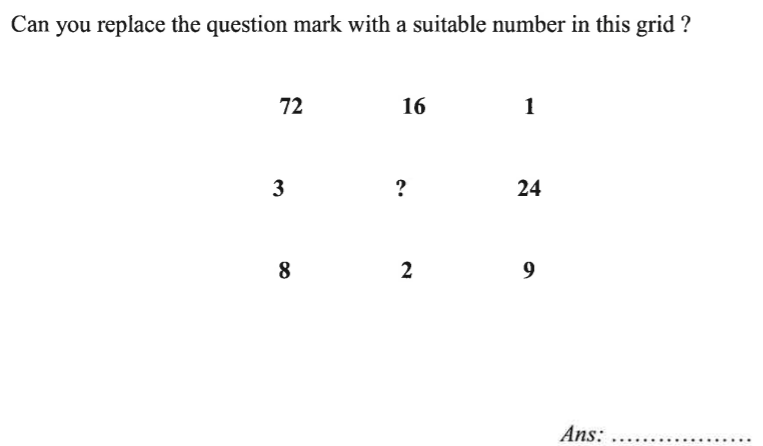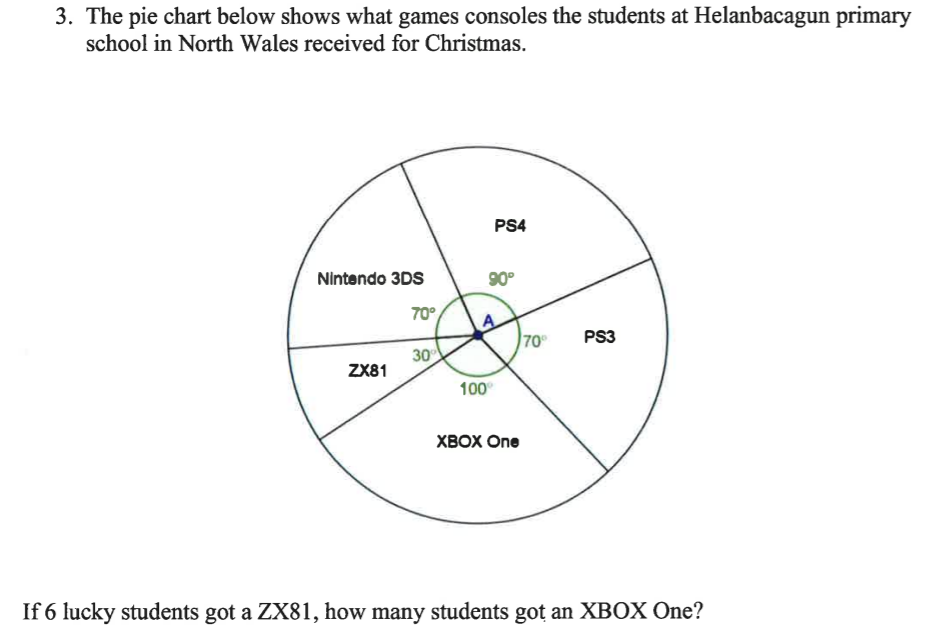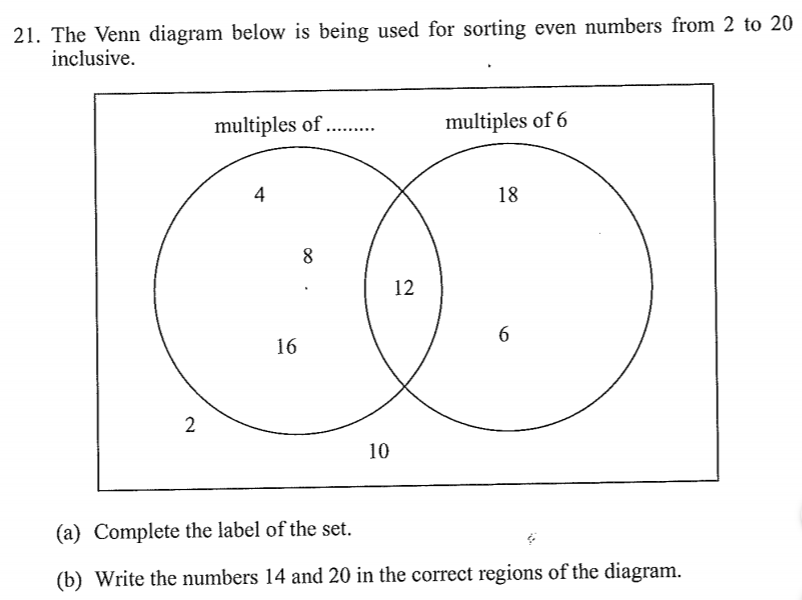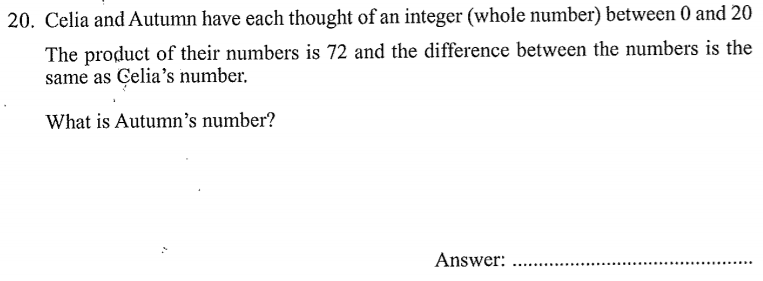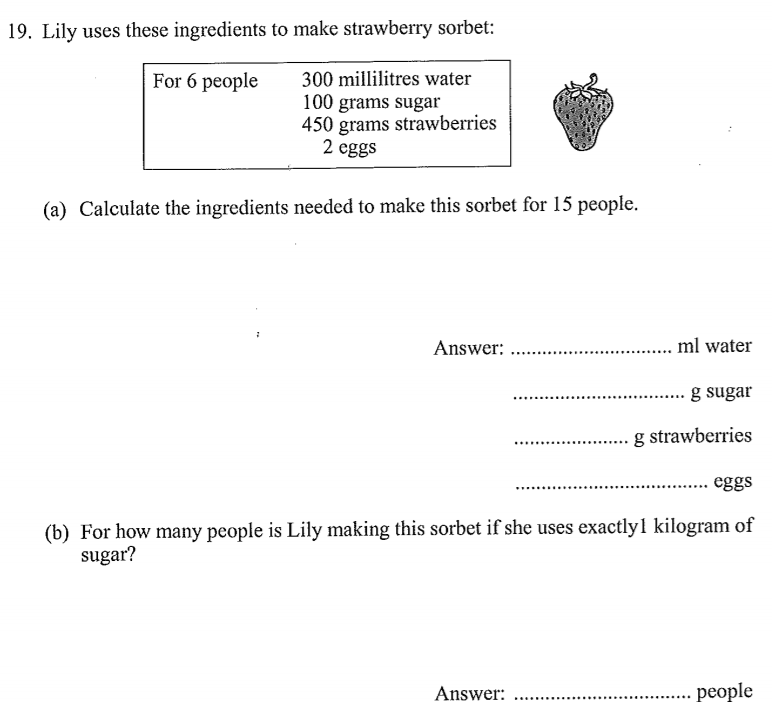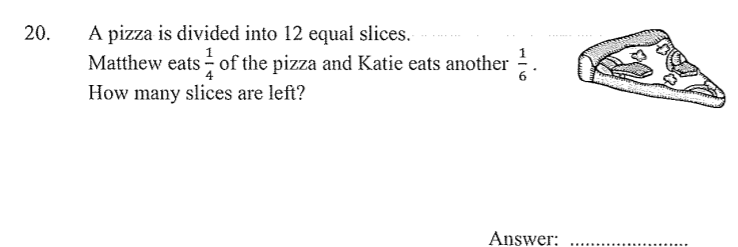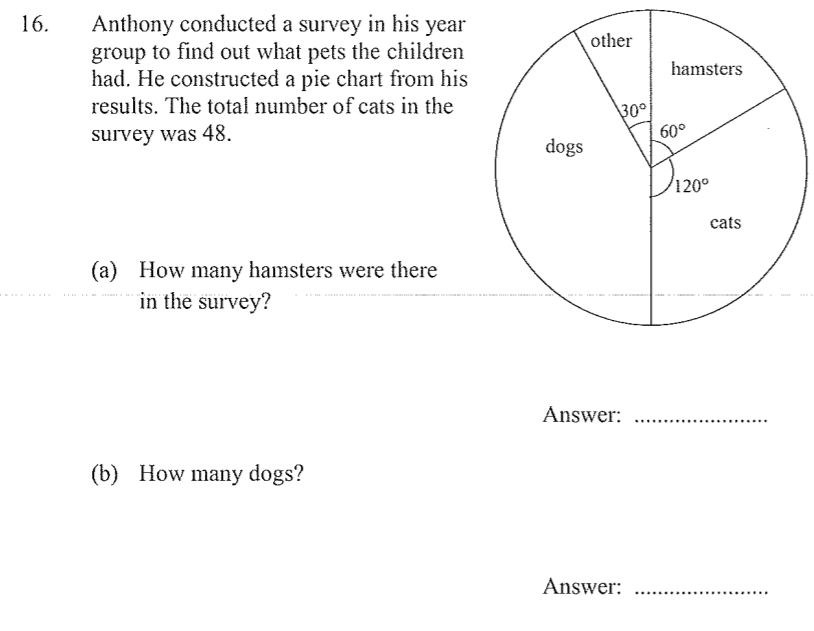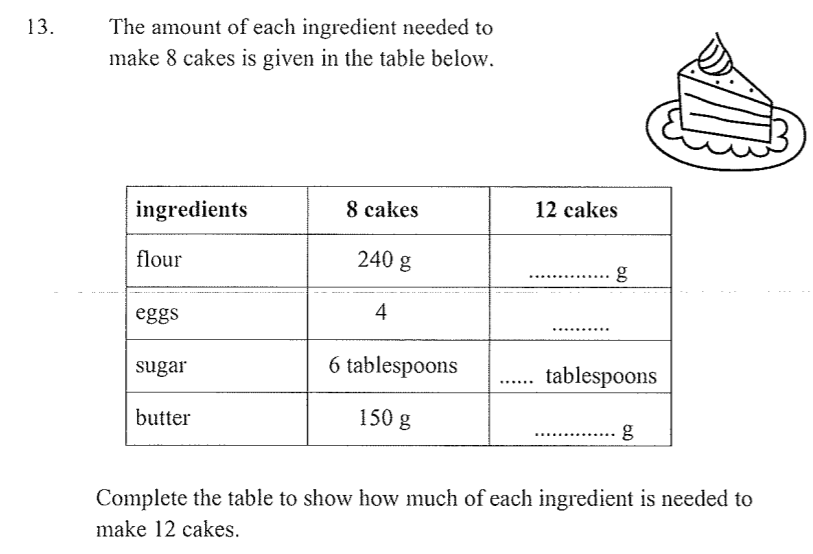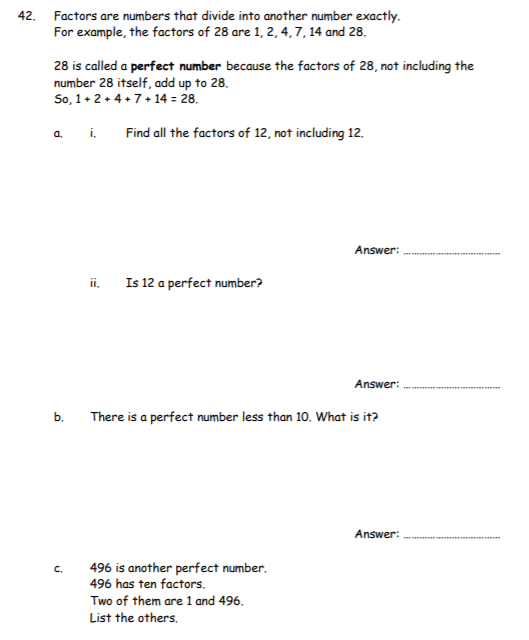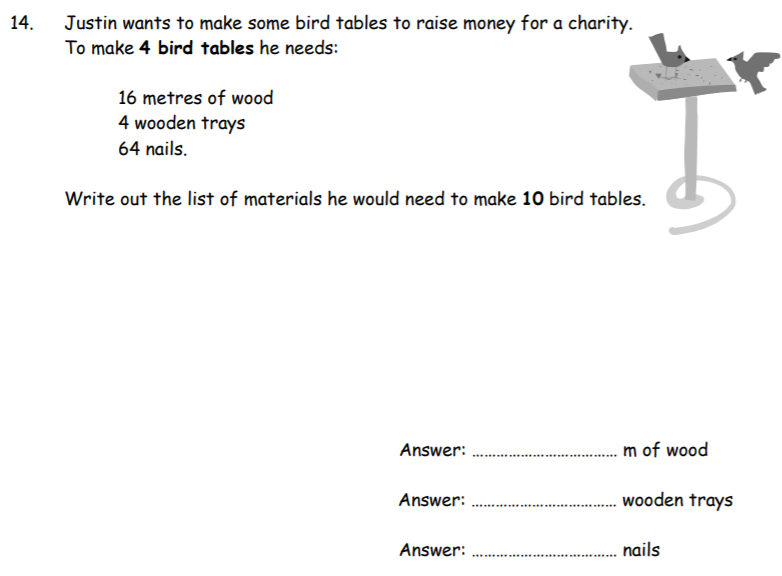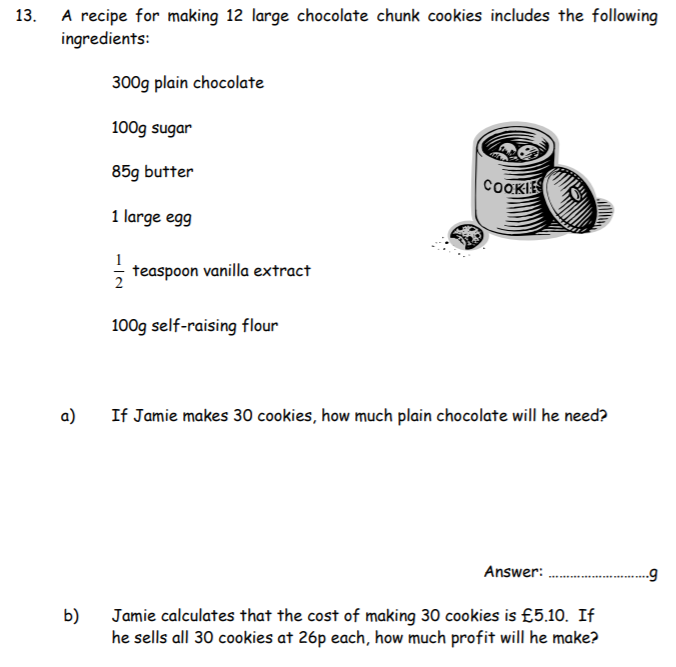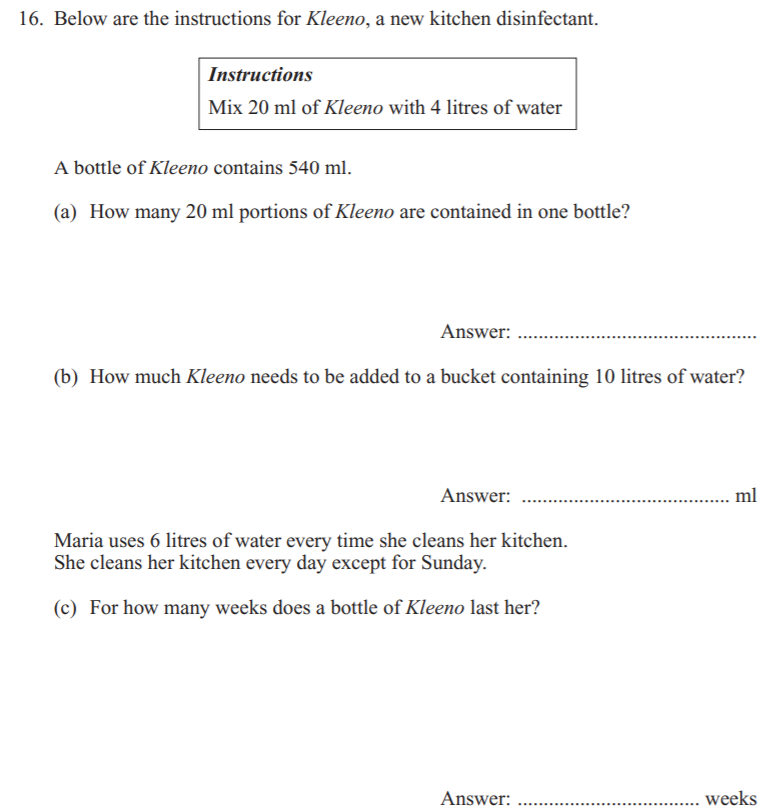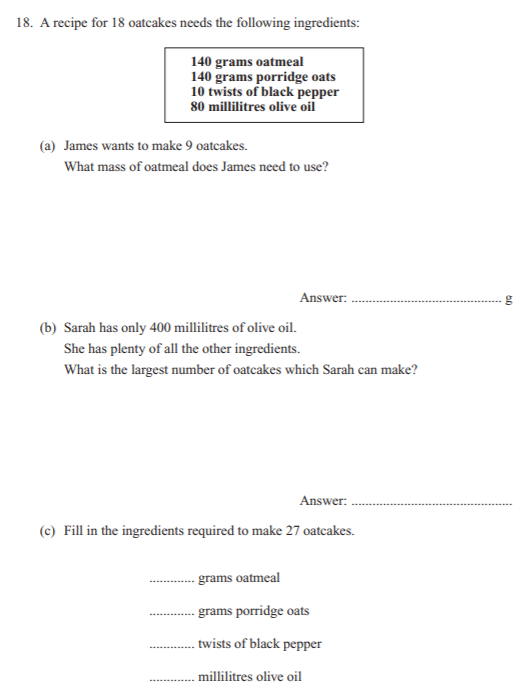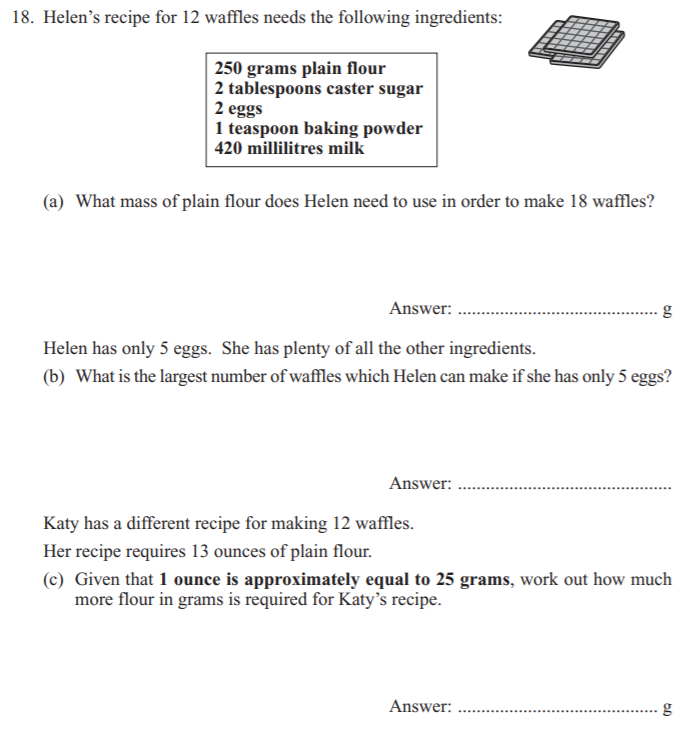B
A+C+D = 70%. Therefore, 30% chose B.
If 25% = 320, what does 30% = ?
The approach is to use HCF of 25 and 30 which is 5%. Work out 5% first of 320
This equals 64
Then 64 * 6 (given that 30/5% = 6 times)
Total is 384
4
So the highest number that goes into 12 and 20
4,8 & 20
C
The answer would be the highest factor of both 8 & 20 from the options since each tile is square. The answer to this is 4
49
- Look for multiples of 7 between 20 and 80
- So 21,28,35,42,49,56,63,70,77
- 49 is the only one that will be a multiple of 5 next year
12:00pm
- The way to look at this is the lowest common multiple of 3,5 & 8.
- This is best done by doing your 8 times table and finding the first number that 3 & 5 also go into
- This is 120. So equivalent is 120 minutes
- Time is 12:00
a) 1/15
- Convert to the same denominator
- So this would mean Tom 3/5 = 9/15 and Jerry 1/3 = 5/15
- In total, 14/15ths has been eaten leaving 1/15
b) 250g
- If Tom had 3/5 = 150g, then 1/5 = 50g
- Therefore 5/5 = 250g
11/35
- Convert to the lowest common denominator which is 35
- So 2/5s becomes 14/35 and 2/7s becomes 10/35
- Add together so 24/35
- This leaves 11/35
0.5 hours
- In one hour, Sachin can clean 1/3rd of the house
- In one hour, Peter can clean 1/6th of the house
- Convert to the same denominator which is 6
- So Sachin = 2/6 and Peter = 1/6
- Together, it takes 3/6 divided by 6/6 = 0.5 hours
18
- B=2 ; A=5
- If A = 45 turns, it has done 9 times as many as the “base case”
- Therefore, B will also do 9 times as many so its 18 times
42
- Work through the multiples and add on the remainder where necessary
- 4 – So multiples with 2 added on would be 6,10,14,18,22,26,30,34,38,42
- 5 – So multiples with 2 added on would be 7,12,17,22,27,32,37,42
- 6 – 6,12,18,24,30,36,42,48
48
- Do your 3 x 4 times table to find a number in between 41 and 51
- So 12,24,36,48
- Answer is 48
1/2
- 1/5th to friend = 2/10ths
- 3/10ths to other friends
- Total left is 5/10
- Always simplify
1 25/36
-
-
-
-
- First convert to improper fraction:
- 9/4 – 5/9
- Convert to Lowest Common Denominator
- 81/36 – 20/36
- 61/36
- 1 25/36
-
-
-
13/24
-
- Convert to Lowest Common Denominator
- 9/24 + 4/24
- 13/24
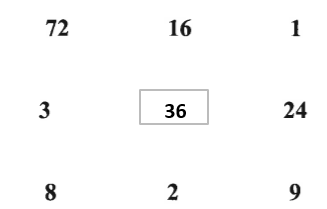
All the common factors of 72
20 students
- Work on basis 6 students = 30°
- Therefore, 2 students = 10°
- So, 100° = 20 students
3
- Convert to 10ths and then back again
- So that would be 6/10 + 3/10
- This would convert back to 3/5 + 3/10
3/12; 2/8; 1/4
- Best way to compare fractions is to convert to the Lowest Common Denominator
- But this is tricky with tight timelines
- Therefore look for a common denominator where possible
- 3/12; 2/8 & 1/4
£6.42
- If 9 pairs cost £19.26, work out the cost of 1 pair first via division
- This would be £2.14
- Cost of 3 pairs would be £6.42
- Or you look at 9 pairs and 3 pairs. HCF is 3. Just divide the £19.26 by 3
7,11 & 39
- The multiples of 13 are 13,26,39,42,55
- The different factors of 77 are 1,11 and 7
- Answer is 7,11 & 39 = 57
6 & 8
- Think about numbers that multiply to give 48. Thats going to be starting with low numbers, 2 * 24, 3 * 16, 4* 12, 6 * 8 etc
- Answer is 6 * 8 as these numbers when added give 14 and multiplied, give 48
16:27
- Logical thinking. Go in multiples of 10 until 6 is also a multiple of that number
- So this gives 30 minutes
- Next time both trains leave the platform at the same time is 16:27
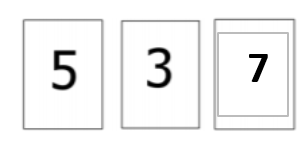
- The rule of thumb to see if a number is a multiple of 3 is to add up all of the digits
- So in this case, 5+3+7 = 15
- If all of the digits added divide by 3, then thats the number
- In this case we were going for the largest number. Smaller options would have been 534 and 531
5 Pens 4 Pencils
- Whatever you buy in pens, just end in a 5 or 0. So the only number this applies to between 0 and 55 is 35
- So its 5 Pens. This leaves 20p
- 20p is for pencils @ 5p each
- So 4 pencils
£4.20
- Work on HCF route. 12 eggs and 18 eggs
- HCF = 6. Therefore, first calculate what 6 eggs costs
- If 12 costs £2.80, 6 costs £1.40
- Therefore, 18 would be 3x what 6 costs. So £4.20
48cm
- You have to think about times tables;
- So the shortest length will be the LCM of 6 & 8;
- This is 48cm
9/25
- The way to address this is to convert all of the fractions to their simplest form;
- So again…..HCF ! This is such a crucial part of Maths. Understanding your times tables inside out;
- This would give us the following:
3/5 3/5 3/5 9/25 3/5
> So for example, the first fraction 12/20 has the HCF of 4. (12/4)/(20/4) = 3/5
£1.64
- Use the HCF Principle. This always works if there is a HCF
- So the HCF of 9 & 12 is 3. Find the cost of 3 bananas first
- This is £1.23 / 3 = £0.41 for 3 (divide by 3 because there are 3 lots of 3 in 9)
- For 12 bananas, the cost is £0.41 * 4 = £1.64
a) 4
b) See below
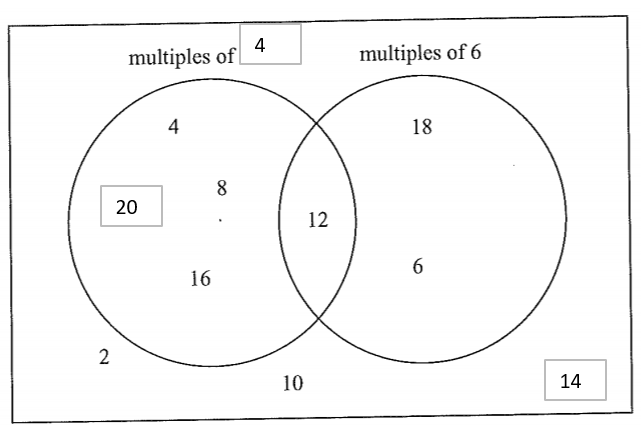
12
Consider the various options to multiply to get to 72.
2 x 36; 3 x 24; 9 x 8, 12 x 6
12 x 6 is the only option which meets the criteria
a) See below
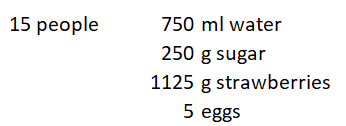
Use the HCF Principle. This is the best approach. So HCF of 6 & 15 is 3. Therefore, work out what is needed for 3 people
Then multiply the result by 5 to get to what is needed for 15 people
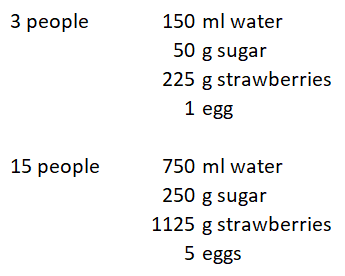
b) 60 people
If 100g is 6 people, then 1kg is 10x 6 people
211
See Calculating the Lowest Common Denominator process on the technique. A process here has been written
7 slices
- This question is again one related to HCF and multiples.
- So convert to 12ths to make the question easier
- Matthew eats 1/4 = 3/12
- Katie eats 1/6 = 2/12
- So this leaves 7 slices
a) 24
- Give that Cats = 48 = 120º
- Hamsters = 60º. Therefore, they are half of cats = 24
The true way to look at this question is to say if 120º = 48, then what is the HCF of 60 & 120. This is 60. Therefore, take the 120 and say how many 60s go into 120. This is 2. Therefore, 60 = 24
b) 60
- Cats 120º + Hamsters 60º + Other 30º = 210º
- Remainder is 360 – 210 = 150º
- Again, HCF principle. Given you know 60º = 24, what is 150º?
- HCF = 30. So 30 is half of 60 so it equals 12
- Then how many 30s into 150 = 5
- Therefore 5 * 12 = 60
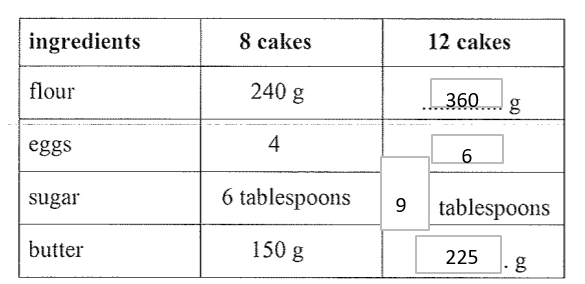
- The easiest way to complete these questions is to think about the HCF multiple.
- Look at how many cupcakes you have ingredients for. Its 8. You need to complete for 12.
- HCF of 8 & 12 is 4. Therefore, if you work out the ingredients for 4 cupcakes, then you can multiply up by 3x to get to 12
- So for 4, its half of what is required for 8
- So butter would be 75g.
- x3 would give you butter for 12 cakes etc
36
3 x 4 is 12 so think of multiples of 12 between 30 and 40
a)i) 1,2,3,4,6
a)ii) No
This is because 1,2,3,4,6 add up to 16 and not 12
b) 6
Because 1+2+3 = 6
c) 2,4,8,16,31,62,124,248
Apply the factor tree approach. So you get :
496 = 248 * 2
248 = 124 * 2
124 = 62 * 2
62 = 31 * 2
Highlighted numbers are Prime Numbers. So 31 x 2 x 2 x 2 x 2 = 496
Therefore, factors of 496 = 2,4,8,16,31,62,124,248
40 metres; 10 wooden trays; 160 nails
The approach:
- There are 2 approaches.
- Work out what it would be for 1 bird table and then multiply up by 10 to get the total for 10 bird tables. However, this approach means that you start to deal in decimals as you would need 0.4 wooden trays per bird table. This can sometimes cause errors down the line
- Therefore, the approach I advocate is HCF.
-
- Look at the core numbers which is that you have the “requirements” for 4 bird tables and need to work out what is required for 10
- The HCF of 4 & 10 is 2
- Therefore, calculate what is needed for 2. In this case, that would be halving what you need for 4.
- So for 2 you need 8 metres of wood, 2 wooden trays and 32 nails
- Then work out “how many batches of 2s” you need to get for the required 10 tables
- So this is 5 batches
- The answer becomes (5 * 8 metres of wood); (5 * 2 wooden trays) and (5 * 32 nails)
-
9 & 4
- The way to tackle this question is think of multiples of 36. This would be 1,2,3,4,6,9,12,18,36
- The 2 numbers with a difference of 5 are 9 & 4
18
Work these questions always with the following approach:
3/8 * 48/1
Then simplify to:
3/1 * 6/1
Easier to get to the answer of 18
2/5 1/2 5/8
- Convert all fractions to the lowest common denominator
- The LCD of 5, 8 & 2 is 40. Always easiest to work by going through the highest of the 3 numbers. So count in 8s
- Revised fractions are as per follows so it now becomes much easier to rank these:
16/40 25/40 20/40
144
You can take the factor tree route per this article:
https://123tutors.co.uk/finding-the-lowest-common-denominator/
3/5 29/45 2/3
- Convert to the same denominator to make it easier to compare
- Lowest common Multiple of 3, 5 & 45 is 45.
- 2/3 becomes 30/45
- 3/5 becomes 27/45
Change from £5 = £5-£1.39 = £3.61
55p + 84p = £1.39
500g of Sugar. £1.10 per kg. Therefore 500/1000 = 1/2 so 1/2 * £1.10 = 55p
750g of flour. £1.12 per kg. Therefore 750/1000 * 112/1. Think of HCF though. The HCF of 750 *& 1000 is 250. Therefore, given you know what 1000g (1kg) costs, you can work out 250g.
This would be £1.12/4 = 28p per 250g
So 750g of flour = 28p * 3 = 84p
a) 750g
With these types of questions, ALWAYS think of HCF. So for 12 cookies, you need ingredients per above. For 30 you need…..
Well you take the HCF of 12 & 30 which is 6.
Step 1: Calculate what you need for 6 cookies first. 12 cookies requires 300g so 6 requires 150g plain chocolate.
Step 2: 30 is a multiple of 6. So take what you had for 6 cookies and * by 5. To give you chocolate for 30 cookies. So 150g * 5 = 750g
b) £2.70
26p x 30 = £7.80. Less £5.10 cost = £2.70 profit
12 & 3
Think of factors of 36 in order to solve
a) 27
540 ÷ 20
b) 50ml
20ml is added to 4 litres of water. Therefore, think in HCF of 4 & 10. This is 2. So first calculate 2 litres which would be 10ml. Therefore, 10 litres would be 5 * 10ml = 50ml
c) 3 weeks
6 litres of water would be 30ml of Kleeno per day. Therefore if a bottle contains 540ml, this would be equivalent to:
540 ÷ 30 = 18 daily cleans.
Given that the floor is cleaned every day apart from 1 day, then 1 week is 6 days of cleaning. Therefore this represents 3 weeks of cleaning
12 & 5
Think first of multiples of 60. 6 * 10, 12 * 5, 30 * 2, 60 * 1. And so on. The answer being 12 * 5 since 12 -5 gives 7
a) 70g
If 18 oatcakes requires 140g, then 9 would require half of this
b) 90 oatcakes
Need to think of factors. This is the trick to all of these styles of questions. So 80 ml makes 18 oatcakes. Therefore, if she only has 400 ml, then its how many “lots of” 80 do you get into 400. This would be 5 lots. So 5 lots of 18 oatcakes=90
c) See below:
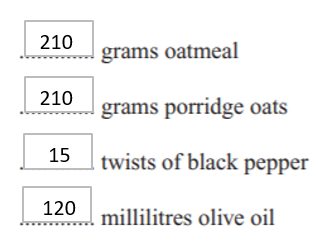
Again, think of factors. Starting point is 18 and this question asks for 27. Therefore HCF of 18 & 27 is 9. If 18 requires X Ingredients, what does 9 require? This is your starting point. 9 requires half of what 18 requires. Therefore, 27 requires 3 times what 9 requires
8 & 7
Best way is to think about multiples of 56. So this might be 28 & 2, 8 & 7 etc. 8&7 is the combination that multiplies to give 56 and added gives 15
63
Think about the multiples of 7 & 9 between 60 & 70
a) 250/2 = 125g (amount for 6 waffles) x 3 = 375g
Think about HCF for 12 waffles v 18 waffles. The HCF for 12 & 18 is 6. Therefore, the best approach is to take 250/2 (to give 6 waffles). Then x that result by 3
b) 2eggs = 12 waffles. Therefore 1egg=6 waffles. 5 will therefore = 30 waffles
Again think about HCF of 2 & 5 which is 1. Therefore, the best way is to work out how many waffles you get for 1 egg and proceed from there
c) 75g
1oz = 25g. So 13oz = 13 * 25 = 325g
325 – 250 = 75g more

